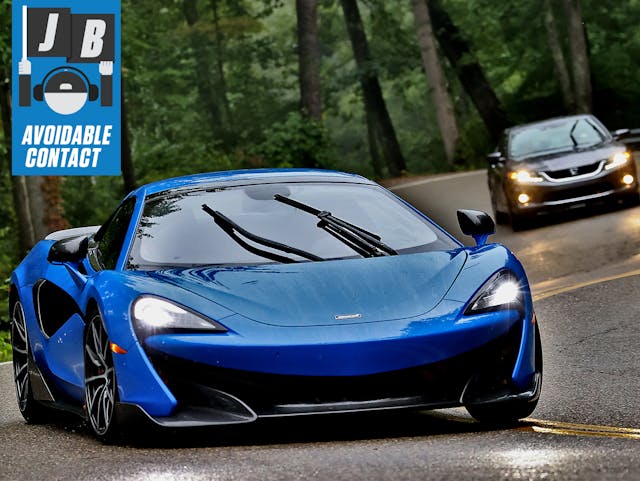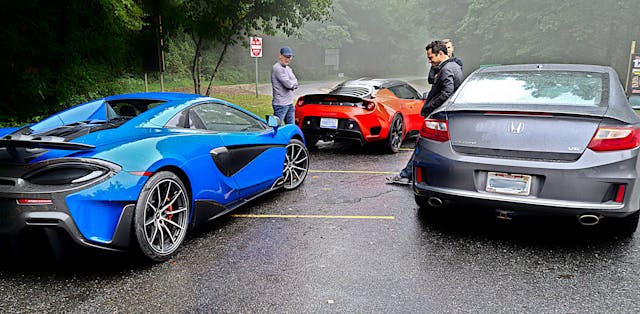Avoidable Contact #79: Hunting for supercars at the Dragon, in the “Marysville Meteor”

“Talk not to me of blasphemy, man; I’d strike the sun if it insulted me. For could the sun do that, then could I do the other; since there is ever a sort of fair play herein, jealousy presiding over all creations.”
I was 14 years old when I read Ahab’s famous quote for the first time, and although I was separated from Herman Melville by over a century’s worth of time and such inventions as the Texas Instruments TI-99/4a Home Computer, let me tell you: I knew exactly what he meant. At the time I was busy trying to strike the sun myself, scrubbing dishes at a pizza place every Friday night so I could pay a $6 Saturday-morning entry fee and race a battered $169 bicycle against all the rich kids and the handsome kids and the effortlessly athletic kids at a BMX track outside Columbus, Ohio.
In the 34 years since I’ve made a habit of tilting at windmills, whether that meant competing heads-up against IBM for tech contracts as a small businessman or racing Pirelli World Challenge using an open-deck trailer and volunteer labor. The more you stack the deck against me, the better. So when my boss, the handsome and well-regarded Larry Webster, told me that he was going on a “supercar trip” to Route 129, the infamous Ass Of The Lizard Tail Of The Dragon, I knew immediately that:
a) I would go;
b) I would bring a Honda Accord.
My pair of ninth-generation Accord V6 Coupes has been very good to me. With the race car, acquired in 2018 from ApexPro’s Andrew Rains, I picked up two awards in Pirelli World Challenge, plus an undefeated NASA regional championship season. In the street car, owned since new by me and currently showing about 84,500 miles, I’ve traveled all over the eastern half of the United States, from Hilton Head to New Orleans to New York City, with pretty much no trouble whatsoever. My initial plan was to pull all the stickers off the race car, trailer it to the Dragon, and spend two great days tailgating half-million-dollar machinery. Larry put the nix on that. “Just bring the regular one. But don’t be slow in it.” Don’t be slow. In a family car with a Blue Book value of $9635. Fine.
The rules of engagement thus laid out, it was time to look at the problem from all sides. I’d driven the Dragon just once before in my life, back in 2006, challenging a local GSX-R rider to a street race for all (or some of) the marbles in a flat-out run that ended with … well, you’ll have to read the book to learn the rest of the story, won’t you? Yet I remembered that the conditions of that particular road already went a long way towards favoring something like a 270-horsepower FWD coupe against, say, a McLaren 600LT. Route 129 has very few straights, and they don’t stay straight for long; I didn’t recall ever exceeding 100 mph in my modestly-powered Boxster S, 14 years ago. It also has a lot of rapid camber changes, which tend to favor cars with higher ground clearance and more suspension travel. Last but not least, most of the corners are blind, which means it’s even more important to have good visibility—and that’s one thing you’ll find both present in the Accord’s standard-equipment list and missing from even the options sheet in a supercar.

I dragged my grey coupe down to Albany Autoworks, my trusty race-prep shop, to start getting it up to spec. Here’s the problem with most street Hondas: they’re slow, but they’re also severely underbraked, even for the modest power on tap. I knew from experience that my Accord could fade its brakes in a single racetrack lap. My race car has aftermarket fixed calipers that are a double “don’t fit”—inside my 18-inch OZ Racing wheels, and inside my budget. So we talked to JB Butler at Hawk Brakes about doing the best we could with the stock hardware. JB offered two options: the Hawk Street 5.0 pads, or the DTC-60 race compound familiar to many sedan racers. I liked the idea of DTC-60, but I didn’t like the idea of flying off a hairpin and into the open sky because my pads had cooled off too much between corners. So Street 5.0 it was. To keep the heat in check, we flushed the whole system with Motul 660 fluid. It’s an open secret in the race business that there are very few brake fluid manufacturers, even though there are many, many labels. Motul 660 is a good way to get the tough stuff at a decent price. I bought six containers from Summit Racing; they arrived the next day. I put cross-drilled Hawk rotors on all four corners just to help shed a little heat, and to make sure that the new pads weren’t contending with any leftover material.
With a little more time, we could have added perhaps 30 horsepower to the Accord’s J35 engine by using an Acura TL-S 3.7 intake manifold and MDX throttle body. That’s a well-researched tactic, developed by Honda of Alabama for the World Challenge cars. As the situation stood, however, we would just have to hope the stock powerband would suffice—small consolation when everything around you is putting two horses to the rear wheels for every horse you’re sending to the front.
What was left, other than a quick re-alignment and torque-to-spec of the suspension? The most important part of all: tires. I had a set of 265-width Pirelli World Challenge slicks that would shade even the most supercar-ish of supercar tires—but it rains a lot in the Blue Ridge Mountains, sometimes without warning and sometimes in relatively small areas. Running on slicks would be a great way to yeet myself off the mountain, as the kids say. What I needed was an all-purpose weapon of a street tire.
I called Michelin to ask for a set of the new Pilot Sport Cup 2 Connect tires. They’ve gained a lot of credibility with the time-trial and autocross crowds in the past six months. But the Michelin people can read a weather chart the same as I can—in fact, better—so they sent me the Pilot Sport 4S. This tire is best thought of as the spiritual successor to the autobahn-focused Michelins of the ’80s and ’90s. Not a pure track tire by any means, it attempts to mix a helping of dry-road adhesion with wet-road security. Plus, it’s made to be quiet and long-lasting and all the other qualities that get thrown out the window when you’re picking a tire for a 200-treadwear race class. I crammed a slightly wider and taller tire—a 245/45ZR18, instead of the factory 235/40ZR18—onto the factory-width wheels for more grip and a longer second gear.

Having sorted the Accord as far as I could, I headed down to the Dragon late on a Wednesday evening, along the way encountering a rainstorm of Biblical proportions. With half of the traffic pulled off the freeway for miles on end, I ran a steady 50 mph on the deep-treaded Michelins and vowed never to say anything bad about “summer-and-rain tires” again. It was still lightly sprinkling the next morning when I caught up with my little group of drivers. Most of the supercars had stayed home, citing rain, but there were a few hardy souls ready to run hard on what would surely be one of the Dragon’s less crowded mornings.

I’m afraid the rest of this story will be a bit anti-climactic, because all the stars aligned in my favor from then on out. With enough water on the ground at any given moment to make it shine in photos, the Accord was simply the only way to fly out there on Route 129. The Hawk brake package was fairly heroic, performing perfectly for the first 60–70 percent of any given run before waving a white flag with a “high, hard” pedal feel. Even then, it was possible to recover the situation by rolling through corners on engine braking for 30 or so seconds, at which point the pads would come back. They were smoking like Sharon Stone in Basic Instinct at the end of every run, but they didn’t give up.
The Michelins turned out to be a real secret weapon. Even on wet ground, they could generate enough cornering force to let the Accord gently wave one rear wheel in the air on the way into turns. There was about zero slack in the sidewalls, a surprise given that a 45-series tire is considered pretty tall nowadays. Most importantly, they offered early and frequent traction reports through the Accord’s relatively inert wheel. I never had any trouble “unwinding for traction” in the midcorner. Time after time the Honda would be pulling hard and making revs out of a turn while the various supercars and sports cars and whatnot were still using their sophisticated traction-control systems to negotiate an exit package.
Alas, the laws of physics still apply everywhere you go, and once we traded the knife-fight confines of the Dragon for the wide-open Cherohala Skyway, the supercars left me for dead within a minute. At the end of a quarter-mile, my Accord is doing 97 miles per hour, but the average McLaren is doing 130-plus. The difference is even greater in reality than it is on paper. At the first gas stop it was my turn to be the subject of good-natured ribbing: “Did you get a flat tire? Were you waiting for someone?” Happily for me, our return route took us back the way we’d come …
… and it was once again given to me to let the big, bland Honda haunt the dreams of better men and better machinery, to spitefully snatch the tiniest secure patch on the way out of a corner and let that single-cam VTEC roar, drowning out the creakings and shiftings of the Accord’s cheap-plastic interior. It started to rain in earnest, the slow sweep of the wipers polka-dotted in my peripheral vision. I switched the traction control off like Luke in the trench of the Death Star and I decided to simply browbeat these gorgeous automobiles ahead of me right off the road. A third-gear downhill sweeper tightened into a second-gear exit. Larry’s blood-red Evora GT filled my windshield. I saw the Lotus stutter-step left, then right as the bossman finessed the throttle. I unwound the steering, aimed the “H” of my grille right into his back bumper, and as I planted the throttle to the stop in one swift and sure motion I found myself channeling Ahab yet again: “From hell’s heart, I stab at thee!”

